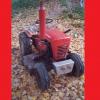-
Similar Content
-
 By Kinjockety
By Kinjockety
The Wheelhorse I am working on is a 1969 Charger 12. It has the hydrostatic lift coming off of the transmission. I will not be using the mower deck and hence, the lift so I want to remove it. It is leaking anyhow so removal is my best option. I have heard if I I simply remove the hoses and plug the openings I could burn out the pump. I am not a mechanic so I do not know where to start. Any advice would be appreciated. Also, if I plug at the control valve does that work? Lastly, how special are the plugs and where can I get them? Thanks in advance for any help.
Mark
-
 By Ifixoldjunk
By Ifixoldjunk
So I was out mowing the other day with my 310-8 and somehow snagged my wheel in a hole in the yard. Anyways I pretty much destroyed my ball joints. I've since replaced the tie rod with junkyard parts but I was wondering if anyone's found a heavy duty aftermarket replacement for the tie rod assembly.
Like would generic adjustable go-kart tie rods do the trick?
-
 By Pullstart
By Pullstart
I unloaded these freebies tonight. I think they are 3 phase. The shop has a phase converter. One drill I’ve had for a bit, the other came tonight. Maybe I can make 1 out of the two. I am not sure what is wrong with them, or if they’ve been upgraded at my FIL’s work.
-
 By tractorman99
By tractorman99
Hi everyone,
I bought a wheel-horse c-160 a while back, and did some work with it.
One day the rear axle housing broke:
I was thinking about changing the part or soldering the broken pieces.
Does anyone know where to order this part? Or has any idea of the potential cost of a soldering job?
Thank you in advance!
-
 By Rich16
By Rich16
Hi! I'm a new member and sure this has been addressed here but how do you remove the gauges on a 520h '91?
I just bought a replacement tach on top right (sticking with all Toro to match) and almost cried when I saw how difficult replacement seems to be. Saw one post about bending the dash cover and loosening the metal piece behind the gauge flange but I tried and don't want to take the chance of breaking the dash cover. Is it necessary to remove the steering wheel and maybe the hydraulic levers to get to them? The voltmeter isn't registering either (bottom left) and it's even more difficult to get to so I don't think bending anything will work. Everything else works perfectly. Help!
Just purchased this 520h with just over 600 hrs and really worried about the rear valve seat issues but it purrs like a kitten and is a delight to hear - love it! The owner mostly restored everything and I'm finishing the job.
-

